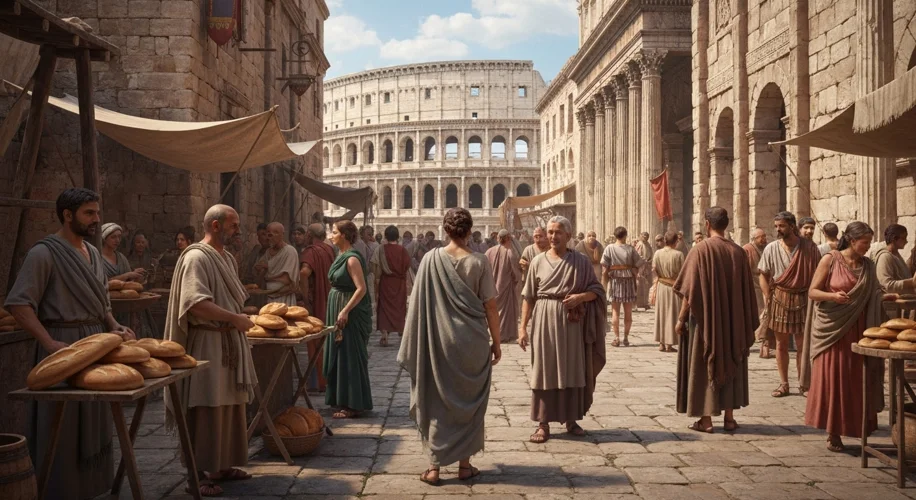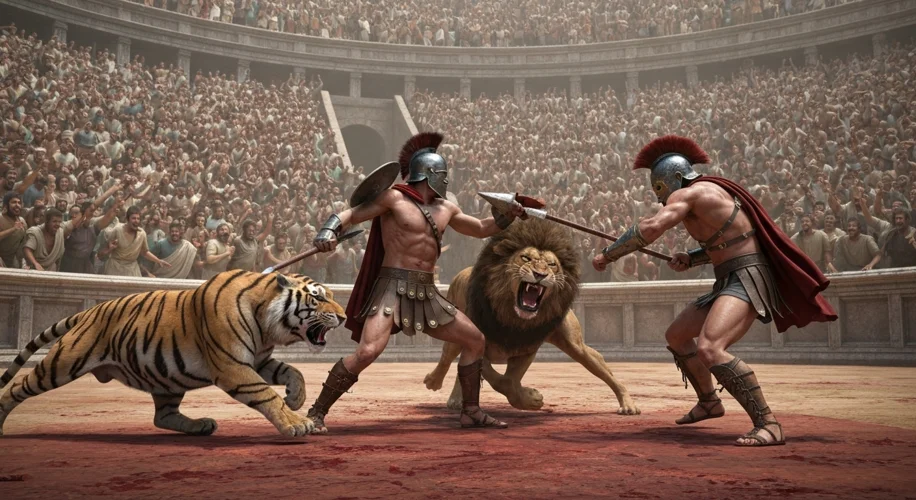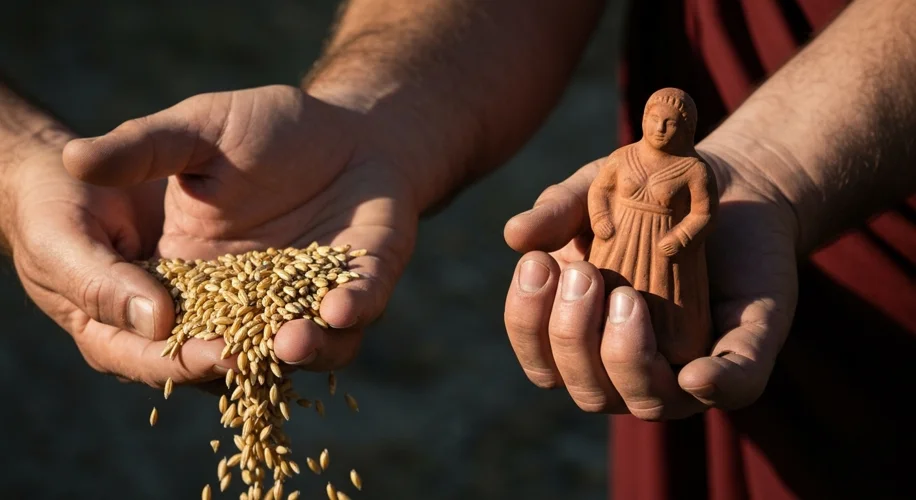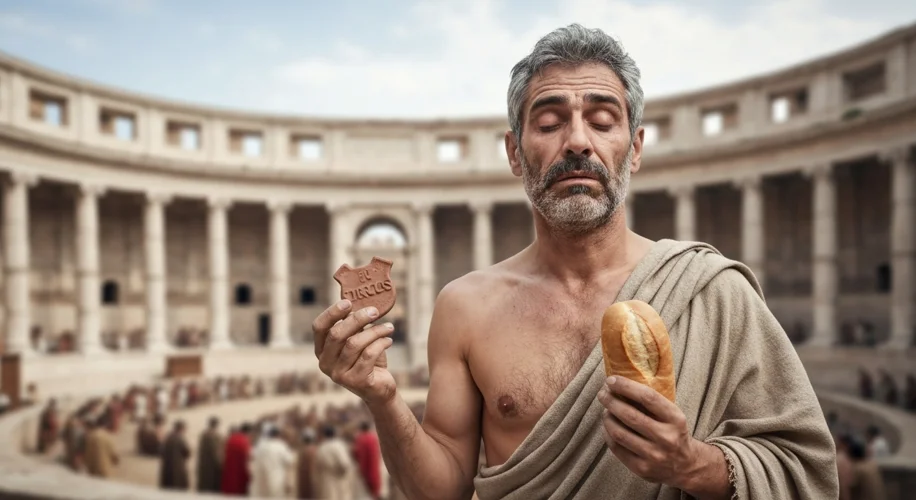The roar of the Colosseum, the scent of roasting meat, the taste of cheap wine – these were the sensory anchors of Roman life for the masses. But beneath the surface of these vibrant spectacles lay a sophisticated, and often cynical, strategy of social control. The phrase “bread and circuses,” or “panem et circenses,” coined by the Roman satirist Juvenal, perfectly encapsulates this ancient method of placating and manipulating the populace.
In the sprawling, complex heart of the Roman Empire, maintaining order among millions of citizens, many of whom lived in abject poverty, was a monumental task. Rome was a city of stark contrasts. Towering marble temples and opulent villas stood in stark opposition to the cramped, squalid insulae – apartment blocks where the poor eked out a precarious existence. For the urban poor, known as the plebs urbana, life was a constant struggle for survival. Unemployment was rife, and the threat of hunger was ever-present.
To quell potential unrest and prevent the kind of revolutionary fervor that could topple even the mightiest empire, Roman emperors and politicians turned to a dual strategy: the provision of basic necessities and the distraction of grand entertainment. The “bread” in “bread and circuses” referred to the grain dole, a system that provided subsidized or free grain to Roman citizens. This was not merely an act of charity; it was a crucial tool for ensuring that the most vulnerable segment of the population had enough to eat, thereby reducing the likelihood of desperation-fueled riots.

The origins of the grain dole can be traced back to the Roman Republic, with figures like Tiberius Gracchus advocating for land reform and grain distribution to alleviate the plight of the poor. However, it was under the emperors that the dole became a more systematic and politically charged institution. Emperors understood that a well-fed populace was a more contented populace. This provision of essential sustenance was often tied to the emperor’s benevolence, further solidifying his image as a provider and protector.
But bread alone, even in abundance, could not satisfy all the needs of the Roman soul. The “circuses” were the elaborate public games and spectacles that captivated the Roman imagination. These ranged from gladiatorial contests, where skilled fighters battled to the death, to wild animal hunts (venationes), chariot races, public executions, and theatrical performances.
The most iconic of these spectacles took place in magnificent arenas like the Colosseum. Here, tens of thousands of Romans could gather to witness displays of martial prowess, exotic animals, and often brutal violence. These games were not just about entertainment; they were carefully orchestrated events that reinforced Roman values and power. Gladiators, often slaves or condemned criminals, were symbols of Roman military might and stoicism. The sheer scale and grandeur of the events served to awe the populace and demonstrate the immense resources and organizational capacity of the empire.

These spectacles served several crucial functions. Firstly, they provided a vital outlet for the pent-up frustrations and energies of the urban poor. Instead of directing their anger towards the ruling elite, they could channel it into cheering for their favored charioteer or condemning a defeated gladiator. Secondly, the games were a powerful tool for propaganda. Emperors used them to showcase their military victories, their generosity, and their ability to maintain order and prosperity. The presence of exotic animals captured from distant lands or condemned criminals from conquered territories served as a constant reminder of Rome’s imperial reach.
Moreover, the distribution of tickets for games, much like the grain dole, could be used to reward loyalty and influence public opinion. Favored groups or individuals might receive preferential seating or special invitations, further cementing social hierarchies while simultaneously creating a sense of shared experience and belonging.
The system of “bread and circuses” was remarkably effective for centuries. It helped to maintain a fragile peace in a city that could easily have descended into chaos. By meeting the most basic physical needs of the population and providing them with constant, high-impact entertainment, Roman leaders were able to divert attention from social inequalities and political grievances.
However, this strategy was not without its critics, even in ancient times. As Juvenal himself observed, the populace had become so accustomed to these provisions that they no longer cared about political participation or their civic responsibilities. They were content to be fed and amused, effectively surrendering their agency in exchange for material comfort and distraction. The “circuses” became a substitute for genuine civic engagement, and the “bread” a means to ensure compliance.

The legacy of “bread and circuses” is a cautionary tale about the dangers of unchecked power and the subtle ways in which populations can be pacified. It highlights the enduring human need for both sustenance and diversion, and how these can be exploited to maintain social order, sometimes at the expense of genuine freedom and progress. In essence, the Romans mastered the art of keeping the masses fed and entertained, ensuring that the cheers in the arena often drowned out the whispers of dissent in the streets.
The “bread and circuses” phenomenon wasn’t just about appeasing the poor; it was about shaping a shared culture of spectacle and consumption that bound Romans together, even as it divided them by class. It was a testament to the power of mass media, even in its most rudimentary forms, to influence public sentiment and maintain the status quo. The lesson from ancient Rome is that while providing for people’s needs is essential, the manner in which it is done, and the accompanying distractions, can profoundly shape the very nature of a society and its citizens.

